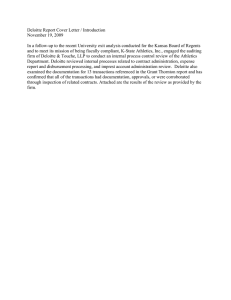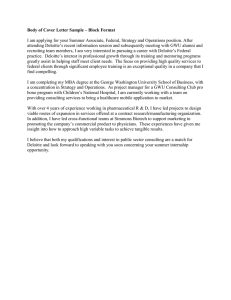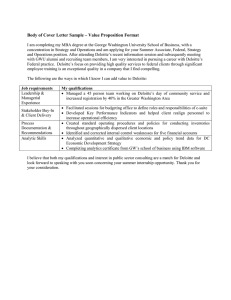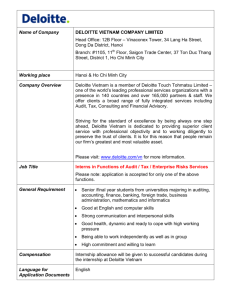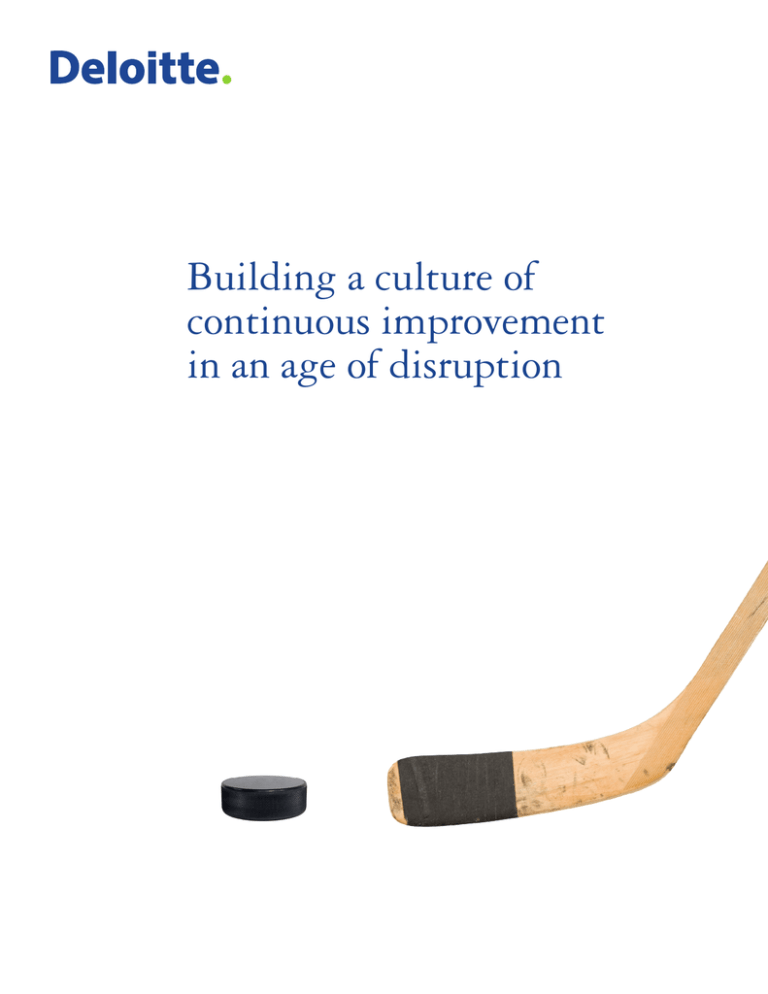
Building a culture of
continuous improvement
in an age of disruption
Many are familiar with the Cinderella story of the U.S.
men’s ice hockey team beating the Soviet Union in the
1980 Olympics. The United States had lost to the Soviet
Union for 20 straight years prior to this match, and won
this critical game during a time of global change fraught
with tense political and economic conflicts.
However, many people are not as familiar with the approach
Coach Herb Brooks used to get his team onto the winner’s
podium. Taking the gold medal was the result of a multiyear
effort to build a strong team culture, focus on effective
metrics, and use small wins to build overall confidence.
For example, Brooks focused on changing his players’
approach from one of being individual stars to being
team contributors. It took a series of poignant encounters
both on and off the ice to gain players’ acceptance of this
approach and to see them put it into action successfully.1
Similar principles are critical to building an effective culture
of continuous improvement in other types of organizations.
Building such a culture is not just about executing a
handful of process improvement projects. That’s a
good place to start – and companies may reap tangible
rewards from those projects. But more is required to
drive sustainable results over time and embed continuous
improvement into the very fabric of the organization.
That’s when the kind of real, transformational changes
take place that can generate hundreds of millions of dollars
of opportunities.
Success rate for continuous improvement
efforts is less than 60 percent.
With such great potential, continuous improvement has
been a highly attractive endeavor for decades. Yet although
many companies recognize the value of the discipline,
they continue to face challenges in turning aspirations into
realities. Indeed, the success rate for these efforts turns out
to be less than 60 percent.2
A major — if not the biggest — factor affecting the
deployment of long-term continuous improvement
initiatives today is the fundamental change taking place
in the way companies manage and execute work.
2
This disruptive shift simultaneously makes continuous
improvement efforts more important while rendering some
traditional approaches ineffective. As a result, companies
are compelled to adapt how they embed continuous
improvement within their organizational cultures.
In this paper, we describe the effects of a changing work
environment on continuous improvement. We then provide
five precepts that can help graft continuous improvement
into a company’s culture so that it becomes part of the
organization’s DNA.
Why today’s changing work environment
disrupts continuous improvement efforts
Establishing an effective culture of continuous
improvement has rarely been easy. The path to building
a continuous improvement culture is littered with efforts
that failed to cross the proverbial goal line. Significant
changes in the current work environment are likely to make
it even harder in the future. Chief among these changes:
the growing need for knowledge workers to perform ad
hoc work, rapidly evolving manufacturing processes, an
increasingly variable workforce, and the potential power
of big data. These changes arguably enhance the potential
rewards of continuous improvement, but they also mean
that strict process definitions alone won’t make continuous
improvement stick. Continuous improvement needs to
be more than just an exercise in better defining and
adhering to processes; it should embody several important
elements that don’t even appear on a process map and
yet are essential to creating a climate that empowers and
equips people to drive improvements in the context of the
changing workplace.
The shift to ad hoc
Today’s work environment is increasingly services oriented.
More employees perform “knowledge work,” characterized
by non-routine problem solving and regular use of
convergent, divergent, and creative thinking3, often in real
time. Some estimates suggest that up to two-thirds of a
knowledge worker’s day is spent on ad hoc, unstructured
tasks that don’t follow standard, prescribed paths.4 These
ad hoc environments are increasingly common in claims
processing, customer service, and complaint management
functions, among others. Because these functions are
flatter organizational structures in which employees are
empowered to make more decisions, they cannot be
managed effectively – much less improved – using rigid
processes alone. Organizations should design effective
continuous improvement processes that focus on value and
key objectives in order to enable flexibility on top of the
appropriate common process “chassis.”
Regardless of the level of flexibility or customization,
there are aspects of most processes that could or should
remain relatively consistent (the “chassis”) while also
striving toward common objectives. Take, for example,
how companies approach making enhancements to their
technology applications. Each enhancement can be very
different in nature – some may only require changing the
options on a drop-down menu, while others may require
a wholesale update of the underlying code. These teams
can adhere to a common set of basic activities (clarifying
customer needs, designing the change, testing it and
implementing), regardless of the complexity, while also
adhering to consistent objectives such as adherence to
delivery dates and customer satisfaction.
Adapting to 3D printing
For companies that manufacture goods, disruptive
technologies and processes such as additive manufacturing
(also called 3D printing) and robotics increasingly require
quick adaptation to stay ahead of competition. These
technologies and processes can lead to improved efficiency,
innovation, and bottom-line cost savings. However, these
innovations also have the potential to completely upend
conventional wisdom and approaches to continuous
improvement. A traditional Lean approach to identify and
remove waste to drive efficiency along the production line
may be usurped by this completely new way of delivering
value to the customer.
The very nature of the workforce is changing
Workforces are evolving to become a mixture of full-time
and part-time employees, contractors, and freelancers.
People also move more freely from role to role and
across organizational and geographic boundaries through
both formal rotational programs and informal channels.
Increasingly, companies are rethinking their resource models
– moving toward project-based work models, building
new “labor supply chains,” and engaging the power of the
crowd – to respond to this desire and structural need for
flexibility.5 The implication for continuous improvement is
that knowledge transfer, documentation, communication,
learning, and accountability measures are more important
than ever before.
Big data creates big opportunities and big challenges
With increasing access to troves of rich and varied data
from diverse sources, businesses should be able to more
easily identify opportunities to improve. In particular,
data analytics (backward looking) and predictive analytics
(forward looking) make it easier for companies to find
patterns in data, which can help to increase customer
value. However, knowing which analytics tools to invest in
and having personnel with the knowledge and skills who
can generate the most relevant outputs from big data
remain significant challenges. This may require continuous
improvement professionals – either within the organization
or external advisors, or some combination thereof – to
elevate their “game” by:
•Understanding which data sources to tap
•Formulating questions and hypotheses that lead to
targeted and efficient data analysis
•Interpreting the results in the appropriate context
including both the continuous improvement program as
well as the broader business priorities
•Communicating results to stakeholders in compelling
and actionable ways so that they don’t get lost amid the
“noise” of other day-to-day activities
A major — if not the biggest — factor affecting the
deployment of long-term continuous improvement
initiatives today is the fundamental change taking
place in the way companies manage and execute work.
Building a culture of continuous improvement in an age of disruption
3
Mastering the disruptive forces of
change with continuous improvement
Given these rapid changes in the workplace,
continuous improvement is even more vital today. It’s
a highly effective mindset, culture, and toolkit for
navigating, focusing, and iteratively improving
amidst the rapid changes companies are undergoing
at many levels. It’s not an easy journey, but five wellestablished, battle-hardened principles of continuous
improvement can lead to effective execution.
4
#1: Persistent leadership
Aligning organizational leaders behind each project and
confirming their sponsorship and involvement is one of
the most fundamental and important factors affecting
continuous improvement. Continuous improvement
doesn’t happen overnight – it is a multiyear journey that
requires long-term vision and commitment, so expectations
and a strong leadership mindset should be instilled across
the organization early in the process.
Equally important is conveying that continuous
improvement is not just a cost-cutting exercise. Rather than
focusing on individual projects, continuous improvement
aims to produce transformational, long-term results. It
can achieve this by building and profiting from the early
momentum generated by initial quick wins, and it requires
striking the right balance between establishing centralized
governance and support and distributing ownership
throughout the organization.
Common pitfalls and implications for
a changing work environment:
Although early momentum often gets leaders on
board, their attention and endurance can waver,
particularly when presented with potentially
disruptive capabilities: for example, big data’s
voluminous insights or additive manufacturing’s
ability to up-end the research, development and
production process.
Over time, individual managers can begin to
impose their own agendas and preferences,
charging off in different directions, chasing
different incentives, and weakening the
investments the organization has made in
developing a cohesive improvement culture.
With change occurring at such a rapid, and at
times, disruptive pace, leaders should make sure
the original vision stays top of mind to provide
critical guidance for long-term success.
Example
One life sciences company anticipated that its continuous improvement journey would be a daunting, multiyear
effort, and the company’s executive team knew that all leaders needed to be fully on board – and needed to stay
that way over time. To accomplish this, the company identified a group of stakeholders that would meet on a
regular basis. Key objectives of the meetings were to reinvigorate the commitment of leaders to their “continuous
involvement plan,” hear their ideas and address their concerns, and equip them with consistent messaging to help
keep their organizations marching to the same beat.
Building a culture of continuous improvement in an age of disruption
5
#2: Real change management
Too often, change management has a bad reputation, and
for good reason. It’s often done too late, it’s too soft, and
it’s viewed as optional. Change management should be
more than just tagging some people as “change agents”,
sending out a pithy communication and putting a few folks
through training.
What’s missing is “real” change management. Continuous
improvement organizations exist to drive change. As
such, they should be experts at managing change. Real
change management is not fluffy or optional. It’s tangible,
quantifiable and critical to driving sustainable adoption.
There are many aspects of change that can and should be
tangibly measured such as how well a future state vision
was communicated or understood, how much people
buy-into that vision and their readiness to change from
the current state. These measures can be translated onto
a change management dashboard with green, yellow,
red colors pinpointing where things are going well and
where targeted efforts are needed to improve awareness,
readiness or capabilities.
Common pitfalls and implications for
a changing work environment:
Change management is frequently an
afterthought rather than an integral part of
a continuous improvement plan. By the time
process improvement teams call in the change
folks when they’re getting ready to implement,
it’s often much too late and hampered by
unrealistic expectations. In fact, many process
improvement teams expect that sending a wellworded email from a senior leader is sufficient
motivation for people to adopt a new way of
working. Not surprisingly, those approaches to
managing change rarely succeed. Given the
fluid and diverse nature of today’s workforce
– or “labor supply chain”, it’s important to be
able to gauge levels of readiness and willingness
across diverse groups of people that may have
very different motivations and allegiances.
Example
The life sciences company mentioned previously soon realized that using consistent messaging alone wasn’t
enough to engage and equip leaders with the tools to instill a continuous improvement culture within the
organization. Instead, it needed a better way to measure and improve its approach to managing change. It
administered regular surveys to gauge what people on the front lines thought, see who was on board, and
determine who was resisting the desired changes. The company was then able to target resources on educating
and engaging employees who might be confused or concerned about the changes.
6
#3: Manage what you measure
Peter Drucker is often credited with popularizing the maxim
“What gets measured gets managed.” But the maxim
doesn’t address an obvious follow-on question: What,
exactly, should be measured?
It’s true that applying metrics and measurements to
behavior can have profound effects. Yet measuring the
wrong things can be counterproductive. For example, a
company striving to provide superior customer service
might not necessarily want to judge employee performance
on the length of calls alone. An effective continuous
improvement culture has an understanding of what should
get measured – and how this measurement results in value
for both the company and the customer.
Also, senior executives should be evaluated on similar
categories of performance as employees on the front
lines are – a concept known as “cascading scorecards.”
The actual metrics should be tailored and relevant at
each organizational level. Implementing cascading
scorecards can align focus and behaviors to common goals
throughout a company, and can help people see how
their day to day actions contribute value to the broader
company goals and priorities. To encourage cultural
change, these metrics should also align to incentives that
drive the right desired behaviors.
Common pitfalls and implications for
a changing work environment:
Big data enthusiasts beware – despite the
exponential growth in data now available at
management’s fingertips, it can be challenging
to separate true signals of value from the noise.
Companies must still go through the process
of defining what to measure, and they must
prioritize what to improve. Big data holds
remarkable promise – but used carelessly can
be a distraction. Companies should maintain
focus and discipline on the key metrics tied to
customer value and quality.
Example
For the life sciences company in our previous examples, metrics became one of the most powerful mechanisms
for engendering cultural change. Management decided to hold organizational leaders accountable to a set of five
high-level metrics, each of which had a dedicated “owner.” These metrics cascaded down to other metrics at other
organizational levels that also had owners. For example, one of the metrics focused on inventory levels; specifically,
how many “days of sales” worth of product was stored in company warehouses. This metric was owned by the
head of production, and it cascaded down to a “forecast accuracy” metric that was owned by the head of supply
chain planning. This enabled the company to align production with forecasted sales. Developing the five metrics
wasn’t easy – leadership had to make hard choices about what and what not to measure. Yet as difficult as
the exercise was, focusing everyone’s attention on very specific metrics was critical to the overall success of the
continuous improvement program.
Building a culture of continuous improvement in an age of disruption
7
#4: Let the data guide the way
There is no one-size-fits-all model for continuous
improvement. Effective companies customize and
incorporate continuous improvement tools and
methods to fit their particular goals, challenges, and
culture. However, one tenet holds true: any continuous
improvement initiative should be based on data-driven
decision making.6
Companies that also invest in analytical techniques, such
as employing quantitative hypothesis testing approaches
and leveraging advanced visualization techniques, are
able to separate facts from speculation and can boost
their chances of success.
As always, companies must choose from among multiple
tools, methods, and concepts when deciding exactly how
to implement data-driven methods. The key is developing
and using a consistent and repeatable approach to
process improvement.7
Common pitfalls and implications for
a changing work environment:
Organizations that lack a strong culture of
data-driven decision making can get caught up
in some variation of “the loudest voice wins.”
Without an objective means of data-supported
decision making, managers with the most
persuasive or aggressive personal styles often
win – whether or not their pet projects are the
most beneficial to the business.
Furthermore, in today’s changing work
environment where ad hoc processes are more
the norm than the exception, tried-and-true
management tools such as process maps and
RACI charts may no longer be as relevant.
Rather, process mining technology tools such
as Process X-ray or Value Stream Mapping
can enable companies to follow what actually
happens in complex, variable processes – and
to more quickly and objectively identify insights
into how to improve.
Example
A company that purchased thousands of pieces of equipment each year for operations was frustrated with
the time required to procure and install the new equipment. The average process lead-time for a new piece of
equipment, from defining the requirements to completing the final installation testing, exceeded four months.
The organization tried several internally promoted ideas for identifying the root cause and reducing the lead-time,
but the problem only worsened. Then leadership enlisted outside help to take an approach that translated existing
ideas into hypotheses and tested those with data. Through this process the company discovered that a bottleneck
at the end of the procurement and delivery process was the real source of delays, not the perceived problems
earlier in the process. By first proving the problem with data-driven measurements, then addressing this bottleneck,
the company not only addressed the real root cause problem, but it also estimated a more than 40 percent
reduction in equipment procurement cycle times as a result.
8
#5: Do fewer things better
Companies with strong cultures of continuous
improvement have sound governance capabilities
that enable them to hone in on top improvement
opportunities, allocate resources effectively and manage
the changes to completion. This frequently means doing
fewer things better.
This concept starts with the rollout of continuous
improvement capabilities. Leading companies start with
smaller-scale, but still fully invested and empowered, pilot
projects before launching on a grander scale across the
business. As their programs grow more dispersed, they
develop a coordinated approach to cross-organization
execution and benefit tracking, focused on a consistent
set of shared priorities across the business.
It may be tempting to rely on an existing organizational
structure to do a top-down rollout of continuous
improvement within a functional group. However, such
an approach can miss some of the biggest and most
valuable opportunities that are usually found by analyzing
and improving the end-to-end process or value stream.
These value streams can cross multiple organizational silos
and business units and the handoffs between groups tend
to be where problems emerge. Successful companies
realize this and put in place methods to prioritize and
coordinate value stream initiatives that resolve conflicts,
assign accountability, and drive toward the greater good
of the overall business.
Common pitfalls and implications for
a changing work environment:
Once they experience some initial success,
organizations can be tempted to take on too
much and can quickly find themselves inundated
with process improvement opportunities. Too
many initiatives underpinned by a sea of data
can prove counterproductive as managers and
front-line employees’ attention and motivation
dissipate from initiative overload.
Indeed, our experience suggests that what
works for continuous improvement in the
beginning of an initiative may not work
18 months later. This is particularly true in
manufacturing and research & development
environments, which have already begun
experiencing the disruptive change potential of
additive manufacturing technologies. Effective
organizations start out with continuous
improvement pilots in one or two process
areas, learn from this experience, and then
adapt accordingly to manage success and
relevance before rolling out to remaining areas.
Example
One company’s continuous improvement program was so successful that it soon found itself with more than 650
projects under way. As the organization took on more projects, fewer actually progressed. So the company put
in place a governance team that used a scorecard to evaluate each existing and proposed project against a clear
set of criteria, narrowing the organization’s focus from more than 650 projects to approximately 100 projects and
emphasizing rapid execution of the highest priority opportunities. This focus now enables them to get more of the
highest priority continuous improvement efforts successfully implemented each year.
Building a culture of continuous improvement in an age of disruption
9
Battling disruption with
focused change
The 1980 U.S. Olympic men’s hockey team built a culture of continuous improvement,
helping them beat long-time rival Soviet Union and eventually capture the gold against
Finland. Coach Herb Brooks applied many of the key principles of continuous
improvement such as persistent leadership over multiple years, real change management
to get the team to think and act differently, and finally, he helped them focus on doing
fewer things but doing those fewer things better. This approach fostered a new and
powerful team culture that helped make Brooks’ - and the team’s - vision a reality.
Outside the rink, effectively embedding a culture of
continuous improvement continues to be a source of
significant, transformational value for businesses
worldwide. The fact that the work environment is rapidly
evolving, driven by economic, cultural, and technological
changes, makes a continuous improvement culture both a
strategic imperative and a growing challenge. By focusing
on the principles outlined in this paper, including
leadership, engagement, metrics, a data-driven approach,
and robust governance, companies can successfully weave
continuous improvement into their DNA. These principles,
drawn from several decades of experience and coupled
with new analytical techniques and abundant sources of
data, can help companies build continuous improvement
cultures that embrace and capture value from deliberate,
focused change.
1 Bob Gourley, “A CTO’s list of lessons from the Miracle of the 1980 Olympics,” Tech Decision Maker, February 22, 2010, http://www.techrepublic.
com/blog/tech-decision-maker/a-ctos-list-of-lessons-from-the-miracle-of-the-1980-olympics/#, accessed May 19, 2014.
2Multiple sources: Deloitte analysis; John P. Kotter, “Leading Change: Why Transformation Efforts Fail,” Harvard Business Review, January 2007,
accessed 2-15-14, http://hbr.org/2007/01/leading-change-why-transformation-efforts-fail/ar/1;
Satya Chakravorty, “Where Process-Improvement Projects Go Wrong,” Wall Street Journal, January 25, 2010, accessed 2-15-14, http://online.wsj.
com/news/articles/SB10001424052748703298004574457471313938130; Christopher Del Angel and Christina Pritchard, “What Went Wrong with
Six Sigma?” Supply & Demand Chain Executive, May 29, 2008, accessed 2-15-14, http://www.sdcexec.com/news/10327161/guest-column-whatwent-wrong-with-six-sigma.
3 “Knowledge Worker Roles and Actions – Results of Two Empirical Studies,” W. Reinhardt, B. Schmidt, P. Sloep, and H. Drachsler, Knowledge and
Process Management, 2011, pp 150-174.
4 Thomas M. Koulopoulos and Nathaniel Palmer, Dynamic Case Management, Delphi Group, 2013, page 3.
5 Human Capital Trends 2013, Leading indicators, Deloitte, 2013, page 8, accessed 2-15-14, http://www.deloitte.com/assets/Dcom-UnitedStates/
Local%20Assets/Documents/Consulting/us_cons_humancapitaltrends2013_040213.pdf
6 “Process Intelligence: Six Tenets of Intelligent Process Improvement,” Deloitte, 2013, page 6, accessed 2-15-14, http://www.deloitte.com/assets/
10
Dcom-UnitedStates/Local%20Assets/Documents/Consulting/us_consulting_ Process%20Intelligence_6_Tenets_ONLINE_FINAL_1120013.PDF .
7 Ibid.
Contacts
David Linich
Jason Bergstrom
Principal
Deloitte Consulting LLP
+1 513 723 4163
dlinich@deloitte.com
Principal
Deloitte Consulting LLP
+1 404 631 2114
jbergstrom@deloitte.com
Special thanks to Rebecca Dupree, Erik Kiewiet de Jonge, and Justine Lelchuk for their contributions to this article.
Building a culture of continuous improvement in an age of disruption
11
This publication contains general information only and Deloitte is not, by means of this publication, rendering accounting, business, financial,
investment, legal, tax, or other professional advice or services. This publication is not a substitute for such professional advice or services, nor should
it be used as a basis for any decision or action that may affect your business. Before making any decision or taking any action that may affect your
business, you should consult a qualified professional advisor.
Deloitte shall not be responsible for any loss sustained by any person who relies on this publication.
About Deloitte
Deloitte refers to one or more of Deloitte Touche Tohmatsu Limited, a UK private company limited by guarantee, and its network of member firms,
each of which is a legally separate and independent entity. Please see www.deloitte.com/about for a detailed description of the legal structure of
Deloitte Touche Tohmatsu Limited and its member firms. Please see www.deloitte.com/us/about for a detailed description of the legal structure of
Deloitte LLP and its subsidiaries. Certain services may not be available to attest clients under the rules and regulations of public accounting.
Copyright © 2014 Deloitte Development LLC. All rights reserved.
Member of Deloitte Touche Tohmatsu Limited


